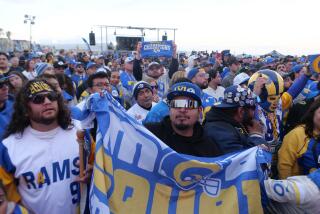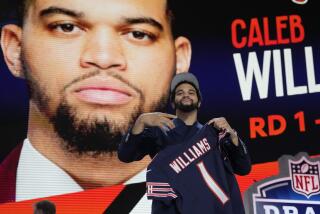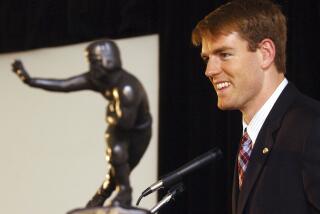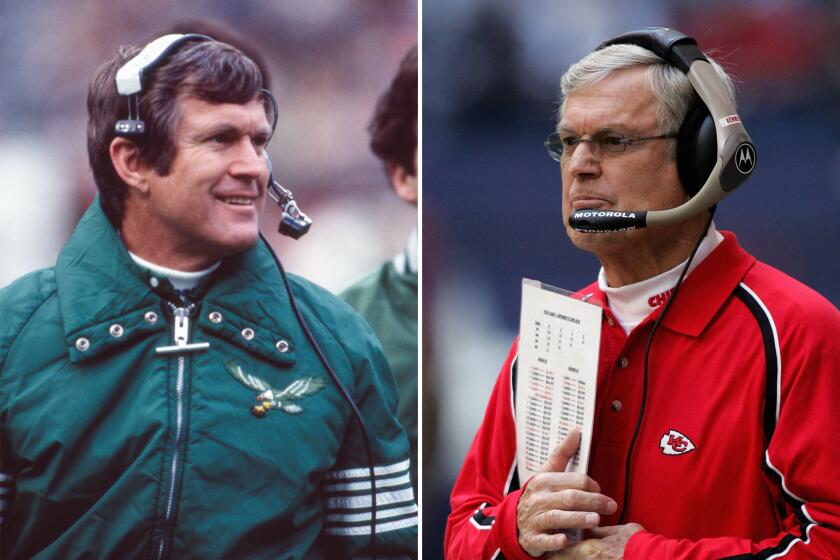Will Torretta Join Ranks of NFL Heisman Failures?
- Share via
One question might be:
How could Heisman Trophy winner Gino Torretta slip through Monday to the next-to-last round of the NFL draft?
For the record:
12:00 a.m. April 28, 1993 For the Record
Los Angeles Times Wednesday April 28, 1993 Home Edition Sports Part C Page 3 Column 6 Sports Desk 2 inches; 51 words Type of Material: Correction
NFL draft--Tuesday’s editions erroneously reported that Navy’s Roger Staubach, picked in the 10th round by Dallas, had been the lowest drafted Heisman Trophy winning quarterback. Doug Flutie of Boston College, having already signed with the New Jersey Generals of the United States Football League, was chosen by the Rams in the 11th round of the 1985 NFL draft.
But the better question, the one they were probably asking in most NFL precincts, is: Why would the Minnesota Vikings bother to draft him in any round?
Torretta was a successful quarterback last season on one of the best teams in college football, the Miami Hurricanes, who had won the national championship a year earlier. But he has never shown an NFL arm.
Nor does he have the mobility to compensate for his deficiencies as a passer. In a football pocket, he is more or less a statue.
He was thumbed down this week by most of pro football’s scouts and coaches, many of whom concluded that Torretta would not have been in Heisman consideration at any other university.
Pros who tried to look at college football as college fans last season tended to back San Diego State’s Marshall Faulk as the best in the game--and in any case as superior to Torretta.
The pros have been wrong often enough. They were wrong when they drafted Gary Beban, Terry Baker and other Heisman-winning quarterbacks in high rounds. And they were wrong when they passed on a non-winner, Joe Montana, for more than two rounds.
But they are harder to fool now. And, except for Minnesota’s personnel people, most will be surprised if Torretta is ever an NFL champion.
Truth is, they wonder what the Vikings were up to this week when they drafted an all-celebrity team: Ohio State running back Robert Smith in the first round, Syracuse wide receiver Quadry Ismail in the second and Torretta in the seventh.
The most celebrated of those is Torretta, whose record at Miami, 26-2, caught the eye of Minnesota Coach Dennis Green.
“There are a lot of things said about Gino--mostly negative,” Green said after the two-day draft. “But we look at what a guy does. And what (Torretta) does is complete a lot of passes, break a lot of records, win a lot of football games and show leadership at one of the toughest programs in the country.”
Torretta’s leadership is an asset, one of three. He also has size--he’s 6 feet 2 and 212 pounds--and intelligence. He graduated from Miami in 3 1/2 years.
He and Green are almost alone, however, in giving him anything more, and Torretta, evaluating himself Monday, went beyond Green.
“I felt I was a first-round quarterback,” he said. “Obviously, I did everything asked of me in college, and I felt I have all the ability to be in the NFL.
“I (completed 598 of 1,090) passes in college, and won 26 of 28 games and two national championships. I have nothing to be ashamed of in my career at Miami, nothing at all.”
Torretta’s case, though, isn’t too different from Beban’s at UCLA, or Baker’s at Oregon State, or John Huarte’s at Notre Dame, or Pat Sullivan’s at Auburn or Doug Flutie’s at Boston College. All won the Heisman. All were drafted high. And all demonstrated that hitting pro targets is more difficult than completing college passes. None made it big in the NFL.
Beban’s NFL log shows five games played, one pass, incomplete; one catch for 12 yards and five runs for 18 yards.
The jury is still out on three other Heisman-winning quarterbacks--Vinny Testaverde, now at Cleveland; Andre Ware of Detroit and Ty Detmer, who stuck with Green Bay last year as the Packers’ ninth-round choice. All have been sitting on one bench or another.
And almost certainly, none is heading for all-pro status. What they all seem to prove--as do all the quarterbacks who have been awarded the Heisman Trophy, with one conspicuous exception--is that it’s easier to win the heart of a Heisman voter than the affection of pro coaches and fans.
The exception is Roger Staubach, one of the great quarterbacks of all time, both at Navy and with the Dallas Cowboys.
Staubach holds another record. Facing four years of active duty in the Navy, he became the lowest-drafted of the Heisman quarterbacks, a 10th-round pick.
NFL Notes
The Vikings weren’t drafting for need when they took Gino Torretta. They will start the season with Jim McMahon at quarterback, leaving Sean Salisbury in reserve, followed by Torretta or Rich Gannon. . . . As the fifth quarterback drafted, Torretta trailed Drew Bledsoe, Rick Mirer and two Washington Huskies: Billy Joe Hobert, a second-round Raider pick, and Mark Brunell, Green Bay’s fifth-round pick. . . . Some scouts listed Mirer and Hobert as the top two.
In the NFL’s first--and last--eight-round draft, teams took the rights to 224 college players this year, down from 336 in last year’s 12-round draft. The difference is 122 players, some of whom will get larger signing bonuses as free agents than as low draft choices. . . . Two of the new free-agent quarterbacks are Shane Matthews and Jamie Martin, who last fall played at Florida and Weber State, respectively. . . . Veteran quarterbacks still on the market are Jay Schroeder, Bubby Brister and Mike Pagel.
The San Francisco 49ers, whose defense has been hit hard by the loss of Pro Bowl stars Charles Haley, Pierce Holt and Tim Harris, drafted for need in the first round with consecutive selections of defensive linemen, Dana Stubblefield of Kansas and Todd Kelly of Tennessee. And, historically, filling needs with first-round draft choices hasn’t been effective in the NFL. But 49er Coach George Seifert said: “I feel pretty good about these players or we wouldn’t have drafted them. They’re quality players for their particular positions.”
Chief President Carl Peterson’s draft report at Kansas City: “We’re very excited and pleased to announce that the Chiefs exercised first-round selections for quarterback Joe Montana and defensive back David Whitmore of (the 49ers).”
The Dallas Cowboys obtained quarterback Hugh Millen from the New England Patriots for an undisclosed 1994 draft choice. The Patriots had told Millen, their starter in 1991 who was plagued by injuries last year, to seek a trade. The Cowboys needed a backup quarterback to Troy Aikman when Steve Beuerlein signed as a free agent with Phoenix last week.
Players Selected in the NFL Draft
BY SCHOOL (2 or more) Alabama: 6 Arizona: 4 Arizona State: 2 Auburn: 3 Baylor: 2 California: 3 Clemson: 5 Colorado: 5 Florida: 2 Florida State: 6 Georgia: 4 Georgia Tech: 2 Grambling: 2 Hawaii: 3 Indiana: 2 Iowa: 3 Jackson State: 2 Kansas: 2 Kentucky: 4 Louisiana Tech: 4 Louisville: 2 Memphis State: 2 Miami: 9 Michigan: 6 Michigan State: 2 Middle Tennessee State: 2 Mississippi: 3 Mississippi State: 4 NE Louisiana: 4 Nebraska: 6 Nevada: 2 North Carolina: 4 North Carolina State: 3 Notre Dame: 9 Ohio State: 4 Oklahoma: 2 Penn State: 2 Pittsburg St. (Kan.): 2 Stanford: 5 Syracuse: 2 Tennessee: 2 Texas A&M;: 3 Texas Southern: 2 UCLA: 4 USC: 3 Virginia: 4 Wake Forest: 3 Washington: 6 Washington State: 3 West Virginia: 2
Note: There were 45 schools that had one player selected in the NFL Draft.
BY CONFERENCE Atlantic Coast: 28 Arkansas Intercollegiate: 1 Big East: 15 Big Sky: 1 Big West: 4 Big Eight: 16 Big Ten: 20 Central Athletic: 1 Gateway: 2 Gulf South: 1 Independent: 30 Lone Star: 1 Mid-American: 4 Missouri Athletic: 2 Mid-Eastern Athletic: 1 North Central: 2 Ohio Valley: 3 Pacific 10: 31 Pennsylvania St.: 1 Southland: 5 South Atlantic: 1 Southeastern: 30 Southern: 3 Southwest: 7 Southwestern Athletic: 6 Western Athletic: 6 Western Football: 1 Yankee: 1
BY POSITION Quarterbacks: 8 Running Backs: 20 Wide Receivers: 27 Tight Ends: 13 Centers: 5 Guards: 11 Tackles: 20 Defensive Ends: 17 Defensive Tackles: 10 Defensive Backs: 43 Linebackers: 37 Kickers: 5 Punters: 4 Kick Returners: 1 Nose Tackles: 3
More to Read
Go beyond the scoreboard
Get the latest on L.A.'s teams in the daily Sports Report newsletter.
You may occasionally receive promotional content from the Los Angeles Times.










